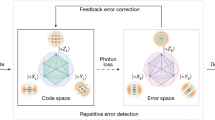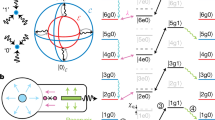Abstract
Logical qubit encoding and quantum error correction (QEC) protocols have been experimentally demonstrated in various physical systems with multiple physical qubits, generally without reaching the break-even point, at which the lifetime of the quantum information exceeds that of the single best physical qubit within the logical qubit. Logical operations are challenging, owing to the necessary non-local operations at the physical level, making bosonic logical qubits that rely on higher Fock states of a single oscillator attractive, given their hardware efficiency. QEC that reaches the break-even point and single logical-qubit operations have been demonstrated using the bosonic cat code. Here, we experimentally demonstrate repetitive QEC approaching the break-even point of a single logical qubit encoded in a hybrid system consisting of a superconducting circuit and a bosonic cavity using a binomial bosonic code. This is achieved while simultaneously maintaining full control of the single logical qubit, including encoding, decoding and a high-fidelity universal quantum gate set with 97% average process fidelity. The corrected logical qubit has a lifetime 2.8 times longer than that of its uncorrected counterpart. We also perform a Ramsey experiment on the corrected logical qubit, reporting coherence twice as long as for the uncorrected case.
This is a preview of subscription content, access via your institution
Access options
Access Nature and 54 other Nature Portfolio journals
Get Nature+, our best-value online-access subscription
$29.99 / 30 days
cancel any time
Subscribe to this journal
Receive 12 print issues and online access
$209.00 per year
only $17.42 per issue
Buy this article
- Purchase on Springer Link
- Instant access to full article PDF
Prices may be subject to local taxes which are calculated during checkout




Similar content being viewed by others
Data availability
The data that support the plots within this paper and other findings of this study are available from the corresponding authors upon request.
References
Nielsen, M. A. & Chuang, I. L. Quantum Computation And Quantum Information (Cambridge University Press, Cambridge, 2000).
Shor, P. W. Scheme for reducing decoherence in quantum computer memory. Phys. Rev. A 52, 2493–2496 (1995).
Steane, A. Multiple particle interference and quantum error correction. Proc. R. Soc. Lond. A 452, 2551–2577 (1996).
Gottesman, D. An introduction to quantum error correction and fault-tolerant quantum computation. Proc. Symp. Appl. Math. 68, 13–58 (2010).
Fowler, A. G., Mariantoni, M., Martinis, J. M. & Cleland, A. N. Surface codes: towards practical large-scale quantum computation. Phys. Rev. A 86, 032324 (2012).
Devoret, M. H. & Schoelkopf, R. J. Superconducting circuits for quantum information: an outlook. Science 339, 1169–1174 (2013).
Cory, D. G. et al. Experimental quantum error correction. Phys. Rev. Lett. 81, 2152–2155 (1998).
Chiaverini, J. et al. Realization of quantum error correction. Nature 432, 602–605 (2004).
Schindler, P. et al. Experimental repetitive quantum error correction. Science 332, 1059–1061 (2011).
Reed, M. D. et al. Realization of three-qubit quantum error correction with superconducting circuits. Nature 482, 382–385 (2012).
Waldherr, G. et al. Quantum error correction in a solid-state hybrid spin register. Nature 506, 204–207 (2014).
Taminiau, T. H., Cramer, J., van der Sar, T., Dobrovitski, V. V. & Hanson, R. Universal control and error correction in multi-qubit spin registers in diamond. Nat. Nanotechnol. 9, 171–176 (2014).
Nigg, D. et al. Quantum computations on a topologically encoded qubit. Science 345, 302–305 (2014).
Kelly, J. et al. State preservation by repetitive error detection in a superconducting quantum circuit. Nature 519, 66–69 (2015).
Corcoles, A. D. et al. Demonstration of a quantum error detection code using a square lattice of four superconducting qubits. Nat. Commun. 6, 6979 (2015).
Riste, D. et al. Detecting bit-flip errors in a logical qubit using stabilizer measurements. Nat. Commun. 6, 6983 (2015).
Cramer, J. et al. Repeated quantum error correction on a continuously encoded qubit by real-time feedback. Nat. Commun. 7, 11526 (2016).
Gottesman, D., Kitaev, A. & Preskill, J. Encoding a qubit in an oscillator. Phys. Rev. A 64, 012310 (2001).
Leghtas, Z. et al. Hardware-efficient autonomous quantum memory protection. Phys. Rev. Lett. 111, 120501 (2013).
Mirrahimi, M. et al. Dynamically protected cat-qubits: a new paradigm for universal quantum computation. New J. Phys. 16, 045014 (2014).
Vlastakis, B. et al. Deterministically encoding quantum information using 100-photon Schrodinger cat states. Science 342, 607–610 (2013).
Sun, L. et al. Tracking photon jumps with repeated quantum non-demolition parity measurements. Nature 511, 444–448 (2014).
Leghtas, Z. et al. Confining the state of light to a quantum manifold by engineered two-photon loss. Science 347, 853–857 (2015).
Ofek, N. et al. Extending the lifetime of a quantum bit with error correction in superconducting circuits. Nature 536, 441–445 (2016).
Wang, C. et al. A Schrödinger cat living in two boxes. Science 352, 1087–1091 (2016).
Heeres, R. W. et al. Implementing a universal gate set on a logical qubit encoded in an oscillator. Nat. Commun. 8, 94 (2017).
Chou, K. S. et al. Deterministic teleportation of a quantum gate between two logical qubits. Nature 561, 368–373 (2018).
Rosenblum, S. et al. A CNOT gate between multi-photon qubits encoded in two cavities. Nat. Commun. 9, 652 (2018).
Albert, V. V. et al. Performance and structure of single-mode bosonic codes. Phys. Rev. A 97, 032346 (2018).
Flühmann, C. et al. Encoding a qubit in a trapped-ion mechanical oscillator. Preprint at https://arxiv.org/abs/1807.01033 (2018).
Krastanov, S. et al. Universal control of an oscillator with dispersive coupling to a qubit. Phys. Rev. A 92, 040303 (2015).
Michael, M. H. et al. New class of quantum error-correcting codes for a bosonic mode. Phys. Rev. X 6, 031006 (2016).
Li, L. et al. Cat codes with optimal decoherence suppression for a lossy bosonic channel. Phys. Rev. Lett. 119, 030502 (2017).
Rosenblum, S. et al. Fault-tolerant detection of a quantum error. Science 361, 266–270 (2018).
Zhou, S., Zhang, M., Preskill, J. & Jiang, L. Achieving the Heisenberg limit in quantum metrology using quantum error correction. Nat. Commun. 9, 78 (2018).
Kurizki, G. et al. Quantum technologies with hybrid systems. Proc. Natl Acad. Sci. USA 112, 3866–3873 (2015).
Wallraff, A. et al. Strong coupling of a single photon to a superconducting qubit using circuit quantum electrodynamics. Nature 431, 162–167 (2004).
Paik, H. et al. Observation of high coherence in Josephson junction qubits measured in a three-dimensional circuit QED architecture. Phys. Rev. Lett. 107, 240501 (2011).
Liu, K. et al. A twofold quantum delayed-choice experiment in a superconducting circuit. Sci. Adv. 3, e1603159 (2017).
Kirchmair, G. et al. Observation of quantum state collapse and revival due to the single-photon Kerr effect. Nature 495, 205–209 (2013).
Khaneja, N., Reiss, T., Kehlet, C., Schulte-Herbriiggen, T. & Glaser, S. J. Optimal control of coupled spin dynamics: design of NMR pulse sequences by gradient ascent algorithms. J. Magn. Reson. 172, 296–305 (2005).
De Fouquieres, P., Schirmer, S., Glaser, S. & Kuprov, I. Second order gradient ascent pulse engineering. J. Magn. Reson. 212, 412–417 (2011).
Barends, R. et al. Superconducting quantum circuits at the surface code threshold for fault tolerance. Nature 508, 500–503 (2014).
Knill, E. et al. Randomized benchmarking of quantum gates. Phys. Rev. A 77, 012307 (2008).
Ryan, C. A., Laforest, M. & Laflamme, R. Randomized benchmarking of single- and multi-qubit control in liquid-state NMR quantum information processing. New J. Phys. 11, 013034 (2009).
Magesan, E. et al. Efficient measurement of quantum gate error by interleaved randomized benchmarking. Phys. Rev. Lett. 109, 080505 (2012).
Carignan-Dugas, A., Wallman, J. J. & Emerson, J. Characterizing universal gate sets via dihedral benchmarking. Phys. Rev. A 92, 060302 (2015).
Cross, A. W., Magesan, E., Bishop, L. S., Smolin, J. A. & Gambetta, J. M. Scalable randomised benchmarking of non-Clifford gates. npj Quantum Inf. 2, 16012 (2016).
Harper, R. & Flammia, S. T. Estimating the fidelity of T gates using standard interleaved randomized benchmarking. Quantum Sci. Technol. 2, 015008 (2017).
Axline, C. et al. An architecture for integrating planar and 3D cQED devices. Appl. Phys. Lett. 109, 042601 (2016).
Chu, Y. et al. Quantum acoustics with superconducting qubits. Science 358, 199–202 (2017).
Tabuchi, Y. et al. Coherent coupling between a ferromagnetic magnon and a superconducting qubit. Science 349, 405–408 (2015).
Kaufman, A. M., Lester, B. J. & Regal, C. A. Cooling a single atom in an optical tweezer to its quantum ground state. Phys. Rev. X 2, 041014 (2012).
Um, M. et al. Phonon arithmetic in a trapped ion system. Nat. Commun. 7, 11410 (2016).
Acknowledgements
We thank N. Ofek and Y. Liu for suggestions on FPGA programming, and L. Jiang, L. Li and R. Schoelkopf for discussions. L.S. acknowledges support from the National Key Research and Development Program of China grant number 2017YFA0304303 and National Natural Science Foundation of China grant number 11474177. S.M.G. acknowledges grants from ARO W911NF1410011 and NSF DMR-1609326. L.S. also thanks R. Vijay and his group for help on the parametric amplifier measurements.
Author information
Authors and Affiliations
Contributions
L.H. and L.S. developed the FPGA logic. L.H. and Y.M. performed the experiment and analysed the data with the assistance of W.C., X.M., Y.X. and W.W. L.S. directed the experiment. L.M.D., C.L.Z. and L.S. proposed the experiment. C.-L.Z., Y.W., S.M.G. and L.-M.D. provided theoretical support. W.C. fabricated the JPA. L.H. and X.M. fabricated the devices with the assistance of Y.X., H.W. and Y.P.S. C.-L.Z., S.M.G. and L.S. wrote the manuscript with feedback from all authors.
Corresponding authors
Ethics declarations
Competing interests
The authors declare no competing interests.
Additional information
Journal peer review information: Nature Physics thanks P. van Loock and the other anonymous reviewer(s) for their contribution to the peer review of this work.
Publisher’s note: Springer Nature remains neutral with regard to jurisdictional claims in published maps and institutional affiliations.
Supplementary information
Supplementary Information
Supplementary Figures and Methods.
Rights and permissions
About this article
Cite this article
Hu, L., Ma, Y., Cai, W. et al. Quantum error correction and universal gate set operation on a binomial bosonic logical qubit. Nat. Phys. 15, 503–508 (2019). https://doi.org/10.1038/s41567-018-0414-3
Received:
Accepted:
Published:
Issue Date:
DOI: https://doi.org/10.1038/s41567-018-0414-3
This article is cited by
-
Protecting entanglement between logical qubits via quantum error correction
Nature Physics (2024)
-
Universal control of a bosonic mode via drive-activated native cubic interactions
Nature Communications (2024)
-
Autonomous error correction of a single logical qubit using two transmons
Nature Communications (2024)
-
Efficient fault-tolerant quantum dialogue protocols based on dictionary encoding without decoy photons
Quantum Information Processing (2024)
-
Real-time quantum error correction beyond break-even
Nature (2023)



